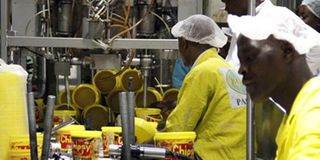Profit from oil seed extraction plant

Workers package edible oil at the Bidco plant. Before establishing the plant, first create a network of farmers who will be supplying you with seed to keep your plant running. PHOTO BY DOROTHY NAKAWEESI
What you need to know:
Uganda has a variety of oil seeds including sunflower, cottonseed, groundnuts, sesame seed and soybean which can be used in operating an oil seed extraction plant, Dorothy Nakaweesi writes.
Uganda’s vegetable oil sector has seen substantial growth. Vegetable oils are used for cooking, baking and in manufacturing. Growth in the sector has been spurred by a number of efforts aimed at boosting the sector by various stakeholders.
The oilseed sector has also grown alongside the vegetable oil sector through development of the value chain. According to data from the Food and Agricultural Organisation, production of oilseeds has grown on average by 17 per cent annually from 2011 to 2014.
Oil seeds produced in Uganda include sunflower, cottonseed, groundnuts, sesame seed and soybean. Oil seed falls under the category of high value products and the demand for it keeps growing in homes, schools, restaurants and hotels.
This growth in production creates an opportunity for one to invest in the establishment of a plant which extracts the actual oils out of the seeds.
This article takes you through how you can start an oilseed extraction plant to make money.
Investment capital
To invest in this venture according to Uganda Investment Authority (UIA), you would require a starting capital of about $20,450 (Shs73.6 million).
“This project idea is designed with an aim of producing 39,000 litres of seed cooking oil with estimated annual revenue of $128,700 (Shs463 million) in the first year of active operations,” UIA records indicate.
This means when production starts, you will be assured of a net profit margin of 34 per cent in a payback period of one year and six months.
The investment scale varies according to the intended objectives of the entrepreneur and the production capacity of the equipment used.
It is anticipated that production costs are assumed for 312 days per year with daily capacity of processing 125 litres of seed cooking oil.
Direct costs include: materials, supplies and other costs that directly go into producing the product.
You may also start on a small-scale with an investment of about $2,000 (Shs7.2 million) to buy the machine on Alibaba.
Production
Ideally, the production process involves drying and cleaning oil seeds to remove foreign materials such as stones, sand and sometimes it is washed to remove dirt.
Then, the outer coat is removed through a process called dehulling and grinded using small motor powered hammer mills. The broken down components are passed through the expeller where they are heated to kill enzymes.
After the oil collects at the bottom of the expeller, it is filtered and stored in a storage tank and packaged. The technology used is very simple as it involves drying, cleaning, crushing, heating and filtering.
Market
The market is wide as oil is a household item with major consumers such as hotels, restaurants, retail and wholesale shops. The major players in the field include; Mukwano Industries Ltd, BIDCO and imported oil from USA.
In Uganda, the northern districts of Lira, Dokolo, Gulu among others, specialise in the production, trading and processing of oil seeds and are organised under the Uganda Oil Seed Producers and Processors Association (UOSPA).
Mr Sydney Ogwali, UOSPA’s regional supervisor in an interview with Prosper Magazine, said: “Investing in this business is very lucrative but one needs to find the right machinery and know the farmers who will supply the raw material.”
UOSPA’s current membership stands at 65 small and medium milling industries countrywide and 947 farmer groups comprising of 47,350 benefiting farmers.
Advice
Experts say before you start this business, carry out a market research.
Mr Newton Buteraba, the chief executive officer of House of Wealth, a local firm that offers business advisory services in an interview with Prosper Magazine, says: “In your business plan, incorporate the entire supply chain right from the farmers who will be providing raw materials all the way to the markets”.
He also says before establishing the plant, first create a network of farmers who will be supplying you with seed to process to keep your plant running.
Supplementing this, Mr Ogwali said when starting this business, you need a location which is not congested with other millers. This will cut back on the competition for the raw material suppliers.
“Have links with farmers and their leaders because they are the ones who control the grain, produce and sales,” he advises.
Your price should also be competitive like the one on the market.
Incentives
Experts from UIA indicate that in this kind of investment, government has incentives including VAT input refunds on starter up costs.
Government is also engaged in skills development where entrepreneurs are taught on how to advance or start doing business. You can seek help from Private Sector Foundation Uganda’s Skills Development Facility programme.




